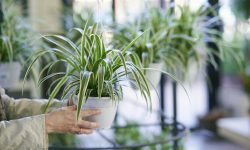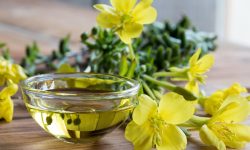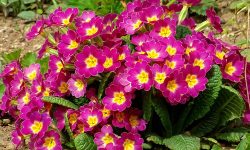Planting a spider plant is one of the most rewarding ways to begin or expand an indoor garden because the plant adapts easily to many environments. Its arching leaves and lively plantlets add a fresh, bright feeling to any room. Many people choose spider plants because they thrive even when care routines remain simple. Their resilience makes them ideal for beginners, yet their graceful form still impresses experienced growers. When planted correctly, a spider plant grows quickly and brings a sense of calm, natural beauty into the home.
Understanding how to plant spider plant properly ensures strong roots, healthy foliage, and long-lasting growth. The planting process affects everything the plant does afterward, from how it absorbs moisture to how well it produces new leaves. Choosing the right soil, pot size, and planting depth helps the plant settle smoothly. A well-planted spider plant becomes more resilient, more vibrant, and more capable of producing plantlets. This guide explores each step clearly, offering expert advice that supports both confident beginners and curious gardeners seeking lush, long-term results.
Understanding Spider Plant Root Structure Before Planting

Spider plants rely on a unique root structure that stores water and nutrients, allowing them to adapt to different indoor environments. Their roots grow thick and fleshy, forming a strong base that supports rapid leaf production. Because these roots hold moisture, spider plants tolerate small periods of dryness better than many houseplants. Understanding this structure helps gardeners choose the right planting method. When the roots feel comfortable, the entire plant grows with greater stability and confidence. A solid foundation ensures that the spider plant will thrive after planting.
The root system also expands quickly when given proper space. Spider plants dislike tight, compacted soil because it restricts their natural movement. A light, airy potting mix allows roots to spread efficiently and absorb nutrients evenly. When planted in loose soil, the roots form a balanced structure that supports full foliage and healthy growth. Gardeners should avoid planting spider plants too deeply because the crown must remain above the soil surface. This helps prevent rot and allows the plant to breathe. Proper depth encourages smoother development and reduces early stress.
Healthy roots also determine how well the plant adjusts to a new environment. When roots receive enough oxygen and moderate moisture, they begin establishing new growth soon after planting. Constantly wet soil suffocates these roots and slows development. Consistent but gentle hydration helps them strengthen naturally. Recognizing the needs of the root system allows gardeners to avoid common mistakes and create ideal conditions from the start. When roots settle into the soil comfortably, the spider plant grows with bright, arching leaves and a resilient posture. Understanding root behavior is the first key to perfect planting.
Choosing the Ideal Pot and Soil Mix
Selecting the right pot plays an essential role in helping a spider plant establish strong early growth. The container must support drainage because spider plant roots dislike sitting in excess moisture. A pot with several drainage holes allows water to escape easily and keeps the root zone healthy. Terracotta pots work well because they absorb some moisture and prevent the soil from staying wet for too long. Plastic pots retain water longer, which may be useful in dry homes. Choosing a pot only slightly larger than the root ball ensures steady hydration and prevents soil from remaining overly damp.
The soil mix also determines how well the plant adapts after planting. Spider plants thrive in light, airy potting mixes that maintain moisture without becoming compacted. A blend containing peat, perlite, and soft organic matter encourages breathability. This texture allows young roots to expand freely and absorb nutrients effectively. Dense soil restricts airflow and slows growth, so a loose structure becomes essential. Good soil helps the plant anchor itself quickly and reduces early stress. When the mix holds moisture evenly, the plant responds with firm, bright foliage that reflects strong internal health.
Preparing the pot before planting helps create an ideal environment for root development. Gardeners should fill the base with a thin layer of fresh potting mix and gently position the plant at the correct height. The crown must remain slightly above the soil surface to prevent rot. After filling the remaining space with loose soil, the plant feels supported but not compressed. A light watering settles the mix and allows the roots to make contact. Proper pot and soil selection sets the foundation for long-term growth, giving the spider plant the stability it needs to thrive.
Preparing the Spider Plant for Planting
Preparing a spider plant before planting helps ensure smooth adaptation and healthy growth in its new environment. The process begins by examining the roots to confirm they are strong, pale, and firm. Roots that feel mushy or dark may indicate early rot, which requires trimming. Healthy roots absorb water more efficiently and support faster leaf development. Shaking off loose, old soil also helps refresh the plant and prepares it for new nutrients. A gentle inspection prevents hidden issues from affecting growth later. This preparation gives the plant a cleaner start and improves its overall stability.
Cleaning the leaves is another important part of preparation. Dust often collects on spider plant foliage, especially when the plant sits in a warm corner for long periods. Wiping the leaves with a damp cloth removes buildup and improves the plant’s ability to absorb light. Clean leaves also reveal hidden pests that may weaken the plant during planting. If small insects appear, treating the plant before placing it in new soil prevents spreading. This early attention protects young roots and keeps the plant healthy. A well-prepared spider plant enters its new pot with better resilience and energy.
Allowing the plant to rest before planting helps reduce stress. After root inspection and leaf cleaning, giving the plant a short pause in a shaded, quiet area allows moisture levels to stabilize. This pause prevents shock when the plant meets fresh soil. During this rest period, gardeners can prepare the pot and soil, ensuring everything is ready for planting. A calm environment helps the plant adjust more quickly once placed in its new container. When preparation is thoughtful, the spider plant begins its new growth cycle with strength and confidence. Proper readiness always leads to smoother adaptation and healthier long-term development.
How to Plant Spider Plant Step by Step
Planting a spider plant begins with positioning the roots correctly so the plant can settle comfortably into its new pot. Gardeners should place a thin layer of fresh soil at the bottom of the container to create a soft bed for the roots. Holding the plant gently by its base helps guide the roots into the pot without bending or breaking them. The crown must remain slightly above the soil line because burying it too deeply can cause excess moisture to collect around the base. Once positioned correctly, the plant begins to stabilize and prepare for new growth.
Filling the pot with loose, airy soil allows the roots to spread naturally. The soil should fall around the root system without pressing down too firmly. Light pressure around the edges helps anchor the plant without blocking airflow. When the soil texture remains open, roots receive enough oxygen to adapt quickly. Gardeners should check that the plant stands upright and maintains a balanced posture. If the plant leans, adjusting its placement before watering helps prevent uneven growth. These small corrections make the planting process smoother and support long-term stability.
After planting, a gentle watering helps settle the soil and initiate early root contact. Water should move evenly through the pot and drain easily. This first watering sets the moisture tone for the following weeks, giving the plant a calm environment to begin establishing roots. The spider plant may remain still for a few days as it adjusts, but this quiet period is normal. Placing the plant in bright, indirect light helps it start photosynthesis without stress. With the right placement, moisture, and soil structure, the planting process creates a strong foundation for healthy future growth.
Setting the Plant at the Correct Depth
Placing the spider plant at the correct depth is essential because the crown controls how the plant breathes and absorbs energy. The crown must always remain slightly above the soil surface, allowing air to circulate around the base. If the crown sits too low, moisture gathers in the wrong place and increases the risk of rot. Setting the plant too high also creates problems because exposed roots dry out quickly and struggle to anchor. Finding the balance ensures the spider plant settles smoothly and begins forming healthy new roots soon after planting.
The soil should gently meet the lower portion of the plant without covering the crown. Gardeners can use their fingers to create a shallow pocket that supports the root ball securely. When the plant sits at the right height, its leaves stand naturally and maintain their graceful arch. Pressing the soil lightly around the sides helps stabilize the plant without limiting airflow. Loose soil encourages the roots to explore the pot and absorb nutrients evenly. This early support helps the spider plant adapt to its environment and begin growing with confidence.
Once the depth is correct, early watering plays an important role in helping the plant settle. Gentle hydration allows the soil to form light contact with the roots without becoming compacted. As the water drains, the soil structure sets into a stable form that supports the entire plant. Stable positioning helps the spider plant produce strong leaves and prevents leaning during its first weeks. Correct depth also reduces stress during future waterings and keeps the crown dry while the root system remains active. Proper placement ensures healthier growth and a strong start in the new pot.
Watering After Planting for Smooth Root Establishment
Watering after planting is one of the most important steps because new roots need steady moisture to anchor themselves properly. The first watering should be slow, allowing the soil to absorb water evenly without forcing it downward too quickly. This helps remove air gaps that may prevent root contact with the soil. When water drains smoothly through the bottom, it signals that the soil structure supports both hydration and airflow. These conditions give the spider plant a calm start and prevent early stress that could slow its growth.
During the first several days, the soil should remain slightly moist to support new root activity. Newly planted spider plants depend on gentle hydration because their roots are adjusting to fresh soil textures. Allowing the top layer to dry lightly between waterings prevents rot and keeps oxygen flowing through the pot. Gardeners should check soil moisture with their fingertips to avoid accidental overwatering. If the soil feels uneven or heavy, reducing watering helps restore balance. This careful observation strengthens root development and encourages the plant to grow confidently into its new environment.
Lighting and temperature also influence how the soil dries after planting. Bright, indirect light supports early photosynthesis and keeps moisture evaporation steady without causing heat stress. Warm indoor conditions help the roots adjust and begin expanding through the soil. Low light slows evaporation and may require less frequent watering, while strong sun dries the soil too quickly. Placing the plant in a stable location allows the watering routine to stay predictable. As new leaves begin to appear, the plant signals successful establishment. Proper early hydration ensures smoother growth, stronger roots, and a healthy foundation for long-term development.
Providing the Right Light for Newly Planted Spider Plants
Light strongly influences how newly planted spider plants adapt because it fuels early photosynthesis and supports the plant’s recovery after transplanting. Bright, indirect light gives the leaves enough energy without causing stress or overheating. Harsh sun can weaken young foliage, especially when the plant is still adjusting to its new soil and pot. A location near a bright window with filtered rays helps maintain an even balance. When light remains stable, the plant preserves moisture better and directs energy toward root establishment, which ensures smoother early growth.
As the plant begins to settle, observing leaf posture helps determine whether the lighting is appropriate. Leaves that stretch or fade often signal low light, while crisp brown patches may indicate excessive brightness. Adjusting the plant’s placement by a small distance often corrects these issues. East-facing windows offer gentle morning brightness that strengthens new leaves. North-facing windows provide calm, steady light suitable for sensitive plants. If a room receives limited natural light, a soft grow light positioned several inches above the plant can supplement energy without causing heat or dryness.
Lighting routines should remain consistent because sudden shifts interrupt the plant’s rhythm. Newly planted spider plants perform best when the daily light cycle stays predictable. Evening placement away from harsh lamps prevents leaf strain and protects the plant from sudden temperature changes. Over time, the plant responds to proper lighting with richer color and firmer texture. As leaves grow stronger, they help support the plant’s internal processes, improving hydration, nutrient absorption, and overall resilience. Providing the right light during this early stage creates a strong foundation for long-term health and vibrant foliage.
Maintaining Temperature and Humidity for Stable Growth
Temperature plays a vital role in helping newly planted spider plants settle into their environment because young roots perform best under steady warmth. Sudden temperature shifts interrupt early development and may cause the leaves to appear limp or dull. The plant thrives when indoor temperatures remain consistent and free from harsh drafts. Warm, mild conditions encourage strong cell activity and support the plant’s natural rhythm. When the climate stays stable, the spider plant adjusts more quickly to its new soil and begins forming healthier, more resilient growth.
Humidity also influences early adaptation because moisture in the air helps protect tender leaves from drying out. Newly planted spider plants often react strongly to dry indoor air, especially during colder months. Low humidity can cause faint browning at the tips, even when the watering routine is correct. Increasing moisture around the plant through gentle environmental adjustments helps prevent stress and supports smoother leaf development. Placing the plant near other houseplants creates a soft microclimate that mirrors natural surroundings. Observing leaf tips helps gardeners recognize when humidity needs adjustment.
Airflow contributes to the overall balance by preventing stagnant conditions that may encourage pests or excess moisture buildup. Gentle air movement helps maintain leaf freshness while preserving the humidity needed for comfortable growth. Positioning the plant away from air conditioners, heaters, or forceful fans prevents sudden temperature drops or excessive drying. A calm, ventilated space builds a predictable environment that supports stable root and leaf development. When temperature, humidity, and airflow work together, newly planted spider plants grow with steady confidence and maintain bright, graceful foliage throughout their early adaptation period.
Supporting Root Development in the First Few Weeks
Root development determines how successfully a newly planted spider plant adapts because the roots guide moisture absorption and overall strength. During the first weeks, the plant devotes most of its energy underground, even when leaf growth appears slow. This quiet phase is normal and signals that the roots are exploring their new soil. Consistent, moderate moisture helps them expand evenly without becoming waterlogged. When the soil remains light and airy, the roots absorb oxygen easily, which supports faster establishment. A patient approach during this stage builds a stable foundation for long-term growth.
Observing the plant’s posture helps gardeners understand how well the roots are adjusting. Leaves that remain firm and upright usually indicate healthy root activity. If the leaves droop or curl, the soil may be too wet or too dry. Adjusting the watering routine during these early days often corrects the issue. Bright, indirect light allows the roots to focus on steady expansion while the leaves receive enough energy for essential functions. Avoiding fertilizer in the early weeks prevents stress because young roots cannot process strong nutrients. Simple care encourages natural development at a gentle, steady pace.
Environmental stability supports reliable root formation. Newly planted spider plants prefer calm conditions with minimal movement and predictable temperatures. Frequent relocation disrupts soil contact and slows early progress. Light airflow strengthens the root zone by preventing moisture buildup and keeping the environment fresh. As roots strengthen, new leaves appear from the center, signaling successful adaptation. This early milestone shows that the plant has anchored itself securely and can begin normal growth. Thoughtful support during the first few weeks ensures the spider plant gains the resilience and energy it needs to thrive for years in its new home.
Adjusting Your Care Routine as the Plant Begins to Grow
As a newly planted spider plant begins showing early growth, it enters a more active stage that requires gentle adjustments in care. The appearance of new leaves signals that the roots have settled and the plant can handle stronger routines. Light becomes especially important because new foliage develops faster under stable brightness. Keeping the plant in bright, indirect light strengthens leaf texture and encourages steady expansion. Slight increases in watering may be needed as growth increases. These early changes help the plant transition smoothly into an energetic new phase.
The watering rhythm should shift gradually as the plant gathers strength. When new leaves appear regularly, the plant consumes moisture more quickly. Allowing the top layer of soil to dry lightly before watering helps balance hydration and airflow. Overwatering still remains a risk at this stage, so monitoring soil texture stays important. If the leaves broaden and deepen in color, the watering routine is likely correct. Once the plant’s structure becomes fuller, introducing a diluted fertilizer supports stronger leaf formation. Feeding should remain gentle because excessive nutrients may disrupt early momentum.
Environmental consistency continues to influence growth as the plant matures. A stable location with warm temperatures and soft airflow allows the spider plant to build energy without interruption. Frequent moving or sudden changes in lighting can slow progress, so gardeners should adjust placement only when necessary. As the plant grows taller and fuller, its leaves create natural shading that protects the soil from drying too quickly. This evolving balance shows the plant’s improved self-regulation. Adjusting care with these subtle signals helps maintain a healthy rhythm. With thoughtful changes and steady attention, the growing spider plant becomes lush, resilient, and ready for long-term success.
Common Mistakes to Avoid When Planting Spider Plants
Planting the Crown Too Deep
Planting the crown too deep remains one of the most damaging mistakes because the crown controls airflow, moisture balance, and early growth direction. When this part sits below the soil line, moisture gathers around the stem and soft tissues. This extra moisture encourages bacterial activity and fungal growth, which quickly weakens the plant before the roots can adapt. A deeply buried crown also forces the plant to use extra energy pushing its leaves upward toward the light. This slows growth and creates a stressed, uneven appearance during the first weeks. Keeping the crown visible protects this sensitive point and supports natural leaf posture.
Correct crown placement also improves water distribution throughout the pot. When the crown sits too low, water tends to remain stuck around the base, creating an unhealthy environment that roots cannot correct on their own. A properly positioned crown helps moisture flow downward, where the thick roots can absorb water more efficiently. Gardeners should always recheck crown placement after adding soil because planting depth often shifts during pot filling. Making small adjustments before the first watering protects the plant’s structure and ensures smoother early development. With the crown set at the right height, the spider plant stabilizes faster and forms stronger, more resilient foliage.
Using Heavy or Compacted Soil
Using heavy or compacted soil creates immediate challenges because spider plant roots require space to expand and breathe. Dense soil presses tightly against the roots, limiting airflow and trapping water for long periods. This lack of oxygen weakens the root tissue and increases susceptibility to rot. The plant may appear stable at first, but early symptoms soon develop, including pale leaves, slow growth, and reduced firmness. Compacted soil also makes it difficult for new roots to anchor themselves, which slows the plant’s transition and affects long-term health. Spider plants adjust poorly when their roots cannot move freely.
Switching to a well-aerated mix improves nearly every aspect of early growth. Light soil encourages drainage, keeps moisture balanced, and prevents the root zone from collapsing under pressure. Ingredients like perlite, pumice, and shredded bark improve soil structure and maintain pockets of air essential for healthy root function. These components also help excess water escape, protecting the roots during periods of inconsistent watering. When placed in airy soil, spider plants develop brighter leaves, stronger stems, and a symmetrical form. Good soil texture reduces the risk of fungal issues and supports consistent hydration. A breathable mix becomes the foundation for lush, resilient, long-lasting growth.
Watering Incorrectly After Planting
Watering incorrectly is another common mistake because new gardeners often overcompensate after planting. Many assume that fresh soil needs heavy watering, but too much water suffocates the roots and prevents early attachment. Excess moisture remains trapped around the root ball, which encourages rot and interrupts oxygen flow. Underwatering is also a problem because dry soil leaves the roots without the hydration needed to settle into their new environment. Both extremes slow early adaptation and weaken the plant during its most sensitive period.
A steady watering routine helps the spider plant establish strong roots. The soil should stay slightly moist but never saturated, especially during the first two weeks. Allowing the top layer to dry lightly between waterings supports airflow and encourages natural expansion. Checking soil texture with a finger helps avoid guesswork. Placing the newly planted spider plant in bright, indirect light also helps regulate moisture levels by ensuring steady evaporation without heat stress. Correct watering creates a smoother transition and gives the plant the stability it needs to begin growing with confidence.
Monitoring Early Growth and Adjusting Conditions
Monitoring early growth helps gardeners understand how well a newly planted spider plant is adapting because the plant communicates its needs through subtle visual cues. During the first weeks, the leaves may remain still while the roots establish themselves. This quiet phase is normal, but the plant should still look firm and evenly colored. If the leaves start to droop or twist, it often signals moisture imbalance or poor soil structure. Checking the soil’s texture and temperature around the pot helps identify the exact cause. When these early observations guide gentle adjustments, the plant stabilizes more quickly and begins forming stronger growth.
Light also plays a major role in early adaptation. Spider plants respond clearly to lighting changes, so gardeners should observe how the leaves react to their placement. Faded leaves or stretched growth usually indicate insufficient brightness, while crisp edges suggest too much sun. Adjusting the plant’s location by a small distance can restore balance. Temperature consistency is equally important. Sudden drafts slow new growth and place extra stress on the young roots. A warm, calm environment encourages smoother transitions and supports the plant’s internal rhythm. Small refinements in lighting and temperature create noticeable improvements in early growth.
As new leaves start appearing from the center, it becomes clear that the plant is establishing itself successfully. This early growth stage is the perfect time to fine-tune watering routines, light exposure, and airflow. Gentle changes work best, as drastic adjustments can interrupt the plant’s progress. Ensuring the soil remains slightly moist and well-aerated helps the roots continue expanding. When conditions stay predictable, the spider plant grows in a more symmetrical and stable pattern. Careful monitoring during this initial phase sets the foundation for a strong, vibrant plant that thrives long-term.
FAQs About Planting Spider Plants
When is the best time to plant a spider plant?
The best time to plant a spider plant is during spring or early summer because warm temperatures support faster root development. The plant adapts more smoothly when daylight increases and soil stays consistently warm. Planting during this period reduces transplant stress and encourages stronger early growth. These conditions create the perfect environment for long-term success.
How deep should I plant a spider plant?
The crown must stay slightly above the soil surface to prevent excess moisture from gathering around the base. When planted too deep, the crown traps water and may rot. Keeping it visible ensures proper airflow and healthier early adaptation. Correct depth also improves posture and helps the root system anchor more easily during the first weeks.
What type of pot is best for planting spider plants?
A pot with good drainage works best because spider plant roots dislike constant moisture. Terracotta pots remove extra water through their surfaces, while plastic pots retain moisture for longer periods. The ideal pot is only slightly larger than the root ball. This size keeps watering predictable and prevents the soil from staying wet for too long.
Should I fertilize a spider plant right after planting?
Fertilizing immediately after planting is not recommended because young roots cannot process strong nutrients. Feeding too early may cause stress and slow root establishment. It is better to wait until new leaves appear at the center. This sign indicates that the plant has recovered and can safely handle a diluted, balanced fertilizer during active growth.
How long does it take a spider plant to settle after planting?
A spider plant usually settles within two to four weeks, depending on light, temperature, and soil conditions. During this period, most growth occurs underground as roots anchor themselves. Leaves may remain still at first, which is normal. Once the roots strengthen, the plant produces new leaves and begins showing clear signs of healthy adjustment.
Final Thoughts
Planting a spider plant becomes a simple and rewarding process when each step supports steady root development and gentle early growth. With the right soil, proper depth, and stable lighting, the plant adapts quickly and begins forming strong new leaves. Small adjustments in watering, airflow, and placement help the plant settle without stress. As the root system strengthens, the spider plant grows confidently, producing graceful foliage and vibrant color. When given consistent care and a calm environment, it becomes a long-lasting, reliable houseplant that brightens any space with natural, effortless beauty.






